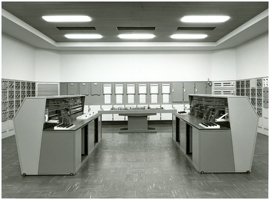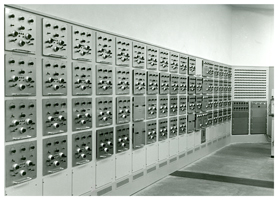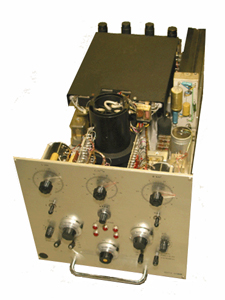Module from the DELTAR tide simulator
UvA Computer Museum catalogue nr 02.43


Deltar room; in the left wall 120 computing modules of the type shown below.
Based on earlier work on electric simulation of hydrodynamic problems that was started in the 1930's and continued after World War II, Deltar was a large-scale analog computer for predicting the tides in the rivers (Rhine, Meuse and Schelde) where they flow into the North Sea. It was designed in 1953 by C.M. Verhagen, and was after its completion in 1961 extensively used up till 1983 [5].
It was well known since the 1920's that simple hydraulic systems can be simulated by analog electrical systems, where the flow of water is replaced by the flow of electricity. Vertical tide (water height) and horizontal tide (flow) are represented by voltage and current, the parameters water storage, inertia and friction by capacitance, inductivity and resistance respectively. In river simulation, the problem can be treated as one-dimensional in space. The difficulty, however, is that most parameters are highly dependent on water height. In simulation, this can be implemented by using variable inductors, capacitors and resistances. This was actually attempted in pre-Deltar experimental systems [2]. However correctly controlling the various parameters turned out to be difficult and unreliable [3,4].

Deltar module (collection UvA Computermuseum). The galvanometers (see text) are visible in the back of the unit. The central cylinder contains the light source for the galvanometers.
Simulations ran in 100 x real-time, which would be impossible with digital computers of that era. Nevertheless, Deltar was quickly overruled by the digital computer, specifically by Electrologica's X1. The digital computer also made it possible to study the two-dimensional problems occuring in see-tides simulation. Besides, in the early 1960's analog computer technology matured quickly: more modern general-purpose analog computers were used until well in the 1970's though not for complex hydraulic problems.
References
[1] Wikipedia: Deltar.[2] Wikipedia: Electrisch model van waterlopen.
[3] C.M. Verhagen, C.M.: Rapport no. 541031, Metingen verricht aan een electrisch model van waterlopen. TPD/TNO 1954.
[4] Rapport Deltacommissie deel 4 bijdrage III.8. Rijkswaterstaat 1960.
[5] Disco, C. and Ende, J. van den: Strong, Invincible Arguments? Technology and Culture 44.3 (2003) 502-535.
[6] Wylie, R.G. and Harper, A.F.A.: An Analysis of the Galvanometer Amplifier. Australian J. of Scientific Research, Series A: Physical Sciences 4 (1951) p.560.
[7] Kocherov, A.V.: Photoelectric Galvanometer Amplifier, Balanced. Photoelectric Galvanometer Amplifier, Balanced. In: The Great Soviet Encyclopedia, 3rd Edition. (1970-1979).
We are indebted to Erwin van Asbeck (Delft) for saving the Deltar module from being scrapped. Much of the information about Deltar, including the b/w pictures, was taken from a collection made available by Erik Verhagen (Haarlem) and Fanta Voogd ('De Ingenieur' magazine). Bart Devilee (formerly at Rijkswaterstaat) provided additional information.
